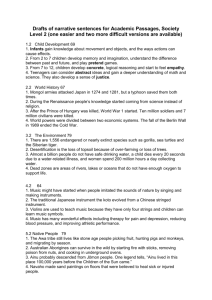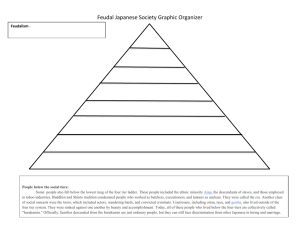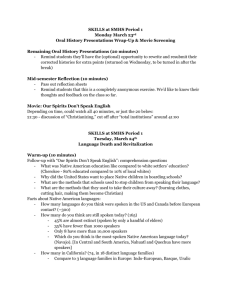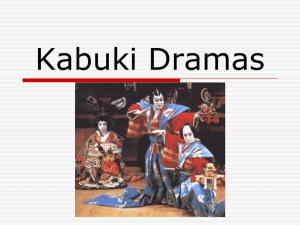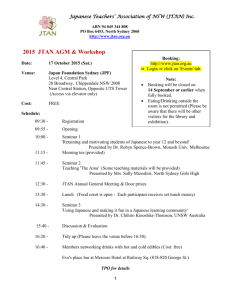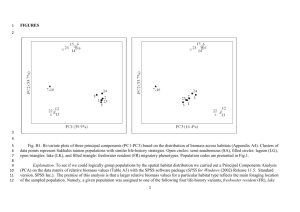SIBERIAN ECOLOGIES AND CULTURES
advertisement
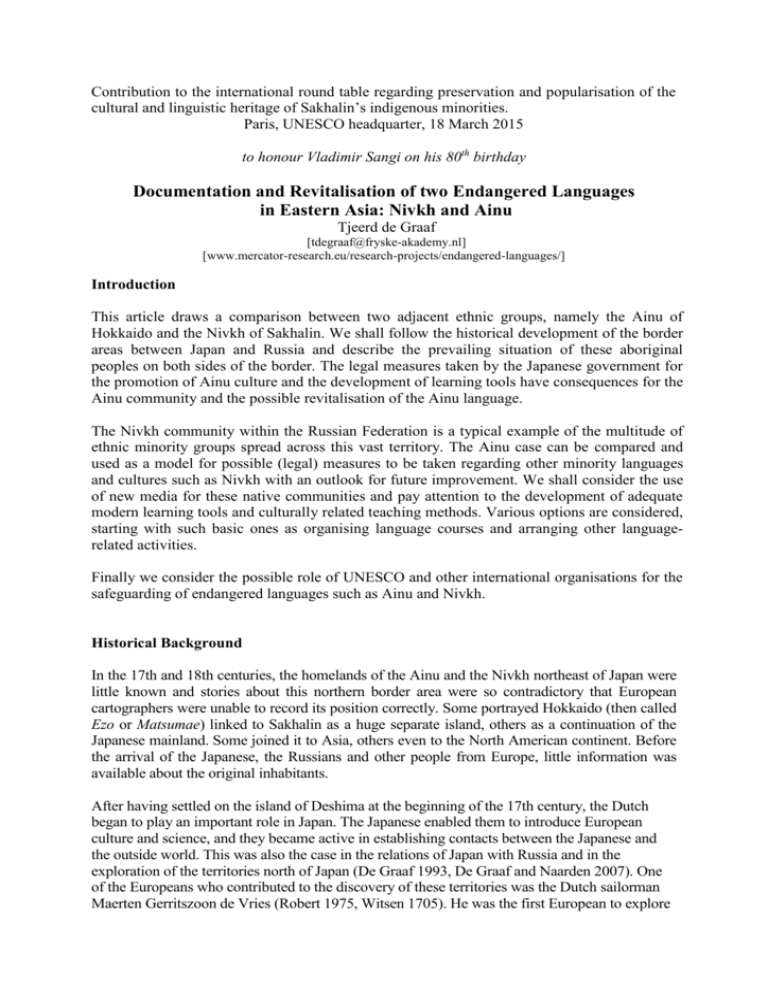
Contribution to the international round table regarding preservation and popularisation of the cultural and linguistic heritage of Sakhalin’s indigenous minorities. Paris, UNESCO headquarter, 18 March 2015 to honour Vladimir Sangi on his 80th birthday Documentation and Revitalisation of two Endangered Languages in Eastern Asia: Nivkh and Ainu Tjeerd de Graaf [tdegraaf@fryske-akademy.nl] [www.mercator-research.eu/research-projects/endangered-languages/] Introduction This article draws a comparison between two adjacent ethnic groups, namely the Ainu of Hokkaido and the Nivkh of Sakhalin. We shall follow the historical development of the border areas between Japan and Russia and describe the prevailing situation of these aboriginal peoples on both sides of the border. The legal measures taken by the Japanese government for the promotion of Ainu culture and the development of learning tools have consequences for the Ainu community and the possible revitalisation of the Ainu language. The Nivkh community within the Russian Federation is a typical example of the multitude of ethnic minority groups spread across this vast territory. The Ainu case can be compared and used as a model for possible (legal) measures to be taken regarding other minority languages and cultures such as Nivkh with an outlook for future improvement. We shall consider the use of new media for these native communities and pay attention to the development of adequate modern learning tools and culturally related teaching methods. Various options are considered, starting with such basic ones as organising language courses and arranging other languagerelated activities. Finally we consider the possible role of UNESCO and other international organisations for the safeguarding of endangered languages such as Ainu and Nivkh. Historical Background In the 17th and 18th centuries, the homelands of the Ainu and the Nivkh northeast of Japan were little known and stories about this northern border area were so contradictory that European cartographers were unable to record its position correctly. Some portrayed Hokkaido (then called Ezo or Matsumae) linked to Sakhalin as a huge separate island, others as a continuation of the Japanese mainland. Some joined it to Asia, others even to the North American continent. Before the arrival of the Japanese, the Russians and other people from Europe, little information was available about the original inhabitants. After having settled on the island of Deshima at the beginning of the 17th century, the Dutch began to play an important role in Japan. The Japanese enabled them to introduce European culture and science, and they became active in establishing contacts between the Japanese and the outside world. This was also the case in the relations of Japan with Russia and in the exploration of the territories north of Japan (De Graaf 1993, De Graaf and Naarden 2007). One of the Europeans who contributed to the discovery of these territories was the Dutch sailorman Maerten Gerritszoon de Vries (Robert 1975, Witsen 1705). He was the first European to explore 2 Hokkaido, the Kurile Islands and Sakhalin, and to draw a map of this region during his voyage in 1643. During his trip, De Vries came into contact with the local Ainu population. Another Dutchman, Nicolaas Witsen, described in his book Noord en Oost Tararye (North and East Tartary) (Witsen, 1705) the voyage of De Vries together with abundant information about the peoples of Northeast Asia, their history, natural environment, culture, language and way of life. An interdisciplinary team of specialists prepared a Russian translation of this book and considered its various aspects: history, ethnology, linguistics, geography, etc. (De Graaf and Naarden 2007). This publication was launched in St. Petersburg in October 2010 and at present (2015) a group of Dutch scholars is preparing a new book publication about the material on the languages and cultures of the peoples in North and East Tartary. After further discoveries and expeditions to this part of the world, its geographic situation became better known and it was found in the beginning of the 19th century that the Ainu people lived on Hokkaido, the Kurile Islands and the southern half of Sakhalin, whereas the Nivkh were their northern neighbours on Sakhalin and the nearby continent. These peoples occupied an area rich in natural resources with abundant deer and salmon. Their culture was based on hunting, fishing and gathering edible plants, and a spiritual relationship with phenomena of the natural world, for the Ainu personified as kamuy, deities. The Ainu and Nivkh people originally did not have a written language but they had a very rich orally transmitted literature which included tales and legends, which expressed the experiences and morals of everyday life from generation to generation. We shall first elaborate on the situation of the Ainu. The Ainu in Japan Originally the northern part of the Japanese main island Honshu was inhabited by Ainu people, whereas there are indications that they also lived on the southern tip of Kamchatka. Traces of the Ainu on Honshu are found in geographic names, but as a result of historical developments the Ainu also disappeared from Sakhalin and the Kurile Islands (De Graaf 2004b). In the sixteenth century many Japanese immigrants began to settle on Hokkaido and to engage in large scale fishing and trading. The Japanese area (Wajinchi) was located in the southern part of the island (Matsumae), while the Ainu people lived in the areas called Ezochi: the rest of Hokkaido (the name of the island since 1868), Karafuto (Sakhalin) and Chishima (Kurile Islands). The southern islands of Etorofu and Kunashiri are at the moment disputed territories between Japan and Russia. Their original inhabitants were also the Ainu and the first map of these islands was made by the Frisian sailor Maarten Gerritsz de Vries and published by Witsen in his book Noord en Oost Tartarye (De Graaf and Naarden 2007, Witsen 1705). The growing influence of the Japanese immigrants and the fact that the Ainu were forced to work for them gave rise to a number of wars, which the Ainu lost. After the battle of KunashiriMenashi in 1789, the Tokugawa Shogunate (Japanese government) gained direct control over the southern half of Ezo, and in 1807 it extended this control to the northern areas. On Hokkaido the Ainu fell completely under the control of the Japanese, who claimed these territories as part of Japan, in this way resisting the growing influence of Russia from the north. In 1854, at the signing of the border treaty of Shimoda between Russia and Japan, it was decided that the boundary would be set between the islands of Etorofu and Uruppu (on Russian maps the Proliv Friza = Strait of De Vries) and that Sakhalin would be made into an ethnically mixed territory. The text of the treaty was written in Dutch (which at that time was the European language most used in Japan) with translations into Japanese and Russian. In 1875, a new border treaty was concluded in St. Petersburg, where Sakhalin became Russian 3 territory and the Kurile Islands part of Japan. Afterwards a large number of Ainu from Sakhalin had to relocate to Hokkaido. They suffered from the abrupt change in lifestyle and the prevalence of diseases, and many of them died. In later times various other forced resettlements of the Ainu would follow and the result is that their number has decreased and that at present they can only be found in Japan, mainly on Hokkaido. During the Meiji era (1868 - 1912), under a government policy of assimilation, the Ainu were oppressed and exploited by the Japanese. The modernisation of Japan caused the central government to pay serious attention to the exploration and economic development of Hokkaido. For this purpose the Hokkaido Settlement Mission (Kaitakushi) was established as an administrative organisation to rule the region, and a large number of former samurai and farmers emigrated from the Japanese mainland to Hokkaido. Ainu mosir (“the people’s land”), where the Ainu had freely hunted and gathered food, became part of the territory of Japan and was given to Japanese immigrants. The Meiji government forced the Ainu to assimilate, and the Kaitakushi prohibited the traditional way of hunting and fishing, and confiscated their lands. Under state-sponsored assimilation policies, discrimination and poverty relegated the Ainu to the lowest ranks of Japanese society. With the introduction of the Japanese way of life and special compulsory education, the traditional system of learning from one’s elders was broken down and the original social and cultural patterns of the Ainu population were destroyed. As a consequence, the Ainu language, together with the traditional lifestyle almost completely disappeared within a couple of generations (Siddle 1996). According to a survey conducted in 2006 by the Hokkaido government, the Ainu population of Hokkaido then numbered 23,782 people (Hokkaido 2006). Many Ainu and people of mixed origin were eager to forget about their Ainu origin and until the present there are many of them who fear discrimination and prefer to hide this origin. Therefore it is rather difficult to estimate the right number of people having the Ainu ethnic background. At present, the number of Ainu living mainly in Hokkaido is estimated at between 24,000 and 50,000, but only very few of them still speak the language. Laws and linguistic rights for the Ainu The Ainu have lived in Hokkaido, Sakhalin, the Kurile Islands and Honshu since ancient times, and have built their own history, language and culture. When the Meiji government enforced its law in Hokkaido, it incorporated the land of the Ainu, basically confiscating their land, forcing assimilation policies, and denying the Ainu people their traditional culture. In this process, discrimination and prejudice toward the Ainu were strengthened. In 1899, the Hokkaido Aborigine Protection Act was passed. This act primarily aimed to provide relief for the Ainu and help them become engaged in agriculture. However, it referred to the Ainu as "former aborigines", which gave rise to further discrimination. In 1946, at the Hokkaido Ainu Convention in Shizunai, Hokkaido, the Hokkaido Ainu Association was established with the aim to provide better education for the Ainu and to create social welfare facilities. In April 2009, the association changed its name to The Ainu Association of Hokkaido (Hokkaido Ainu Kyookai). This association is actively engaged in solving various problems experienced by the Ainu. (see www.ainu-assn.or.jp). In 1984, the Hokkaido Utari Kyookai (Association) proposed that the government should introduce a new law which would replace the Hokkaido Aborigine Protection Act. Since then, the association 4 has conducted an active campaign to demand that the national government enact this law as soon as possible. Furthermore, various activities have been promoted to revive the Ainu language and to preserve and maintain Ainu culture, such as traditional dancing and various ceremonies. During the preparation of this new legislation many controversial problems had to be solved. The original draft, submitted by the Hokkaido prefectural government and the Ainu Association, has been changed by the Japanese government in such a way that, to the regret of several Ainu representatives, it does not mention the rights of the Ainu as an indigenous people anymore, which would allow for the provisions related to the United Nations’ Declaration for the Rights of Indigenous Peoples (Dietz, 1999). However, in this Law on the Promotion of Ainu Culture and Facilitation of Popular Understanding of Ainu Tradition the Japanese government acknowledges for the first time the existence of a separate ethnic group inside the country and calls for respect of its culture and traditions. This is a change in attitude compared to the year 1986, when Prime Minister Nakasone stated that “Japan is a racially homogeneous nation and there is no discrimination against ethnic minorities with Japanese citizenship”. The Ainu then have become an internationally recognised indigenous population. In July 1997 the Japanese government finally introduced the Ainu Shinpo (New Ainu Law) and abolished the 1899 Hokkaido Aborigine Protection Act (Tsunemoto1999). The purpose of this new law is “to realise a society in which the ethnic pride of the Ainu people is respected and to contribute to the development of diverse cultures in the country, by the implementation of measures for the promotion of Ainu culture, the spread of knowledge related to Ainu traditions, and the education of the nation, referring to the situation of Ainu traditions and culture from which the Ainu people find their ethnic pride”. According to article 3 of this Ainu Shinpo, the national government should make efforts “to promote measures for the nurturing of those who will inherit Ainu culture, the fruitfulness of educational activities concerning Ainu traditions, and the promotion of the study of the Ainu culture”. In 1997, after the preparations for the Ainu Shinpo were made by the Hokkaido government, the Hokkaido Development Agency approved the establishment of the Foundation for Research and Promotion of Ainu Culture (FRPAC) as a public service corporation (www.frpac.or.jp). This Foundation has offices in Sapporo (Hokkaido) and at the Ainu Culture Centre in Tokyo. Its mission is in accordance with the Law on the Promotion of the Ainu Culture. It is the sole corporation in Japan with the authority to carry out the services provided in the law. One of the tasks of the Foundation is to preserve and promote the Ainu language and traditional culture and to disseminate knowledge on Ainu traditions to the nation. In the year 2003, the Foundation's projects were implemented based on the following four policies: (1) Promotion of comprehensive and practical research on the Ainu, (2) Promotion of the Ainu language, (3) Promotion of Ainu material culture, and (4) Dissemination of knowledge on Ainu traditions. Teaching of the Ainu Language and Culture The language is unique to the Ainu and forms the core of their ethnic identity. Because the number of people who use the language has been decreasing yearly due to the aging of native Ainu speakers, Ainu language education is in a very difficult state. For the improvement of Ainu language education, the FRPAC provides learning opportunities to train Ainu language instructors through intensive courses on effective instruction methods based on the grammar and linguistics of the Ainu language, in cooperation with Ainu language researchers. Various 5 descriptions of the Ainu language have been produced, such as the grammar by Tamura (2000). Ainu language classes are offered in various community centres on Hokkaido and in the Ainu Culture Centre in Tokyo. These centres are very well equipped with modern facilities and often offer interesting expositions related to the Ainu culture. In order to disseminate the Ainu language to the general public, the FRPAC provides opportunities for many people to have contact with and to learn the Ainu language. Language textbooks are provided free of charge and special books on the Ainu history and culture are edited for primary and secondary schools. People who want to practise the language can take part in special speech contests and storytellers of traditional oral Ainu literature, such as yukar (epics of heroes), kamuy-yukar (stories of deities) and uwepeker (old tales), give direct instruction to train their successors. Special attention is paid to the remnants of the Ainu language in the local culture, in particular the interpretation of geographic place. Since the 1980s the Ainu cultural and ethnic movements have created a public awareness of Ainu heritage, and popularised Ainu culture. The purpose of teaching Ainu history and culture is to promote understanding of the Ainu and their culture, and to refute the Japanese stereotype of the Ainu as uncivilised people. The Hokkaido Board of Education and the Hokkaido University of Education have taken the lead in funding Ainu studies and education. The Hokkaido Board of Education prepared teaching materials for Ainu history and culture in 1984, and in 1992 it produced a handbook, Guidelines for the Teaching of Ainu History and Culture, for every high school in Hokkaido. In 1987, the Utari Association requested that the Hokkaido University of Education teach a course in Ainu history and culture, and in 1991 the five campuses of the University offered seventeen courses wholly or partially devoted to Ainu history, culture, and language. The Ainu themselves, as well as several scholars, are actively researching and writing about Ainu history, language and culture. The 1997 New Ainu Law provides public funds to museums, performance theaters, research centres, and community cultural centres. Japanese students learn about Ainu history and culture as part of the social science curriculum in elementary, middle and high schools. Ainu issues first appeared in the social studies textbooks in 1961. In addition to textbook-centred instruction, elementary school students and preschoolers become familiar with Ainu culture by making handicrafts, reading folktales, and performing music and dance. Watching a documentary on the lifestyle of the Ainu can also give students a sense of Ainu culture. Since 1978, middle school textbooks have included chapters on Ainu history and cultures. A popular history textbook portrays the Ainu as the victims of Japanese exploitation and prejudice. It refers to Ainu revolts as justifiable resistance against exploitation by Japanese settlers and merchants prior to the 1868 Meiji Restoration. Shakushain, one of the leaders of the resistance, is portrayed as a hero. More recently, in 2007, Hokkaido University opened the Centre for Ainu and Indigenous Studies (CAIS) with the aim of promoting comprehensive and interdisciplinary research activities concerning indigenous peoples with a special emphasis on Ainu (see www.cais.hokudai.ac.jp). It also strives to establish networks connecting various organisations at home and abroad with the aim of promoting research programmes on Ainu and indigenous peoples. Currently, the academic staff of this Centre consists of six full-time researchers, twelve part-time researchers and three PhD students from various fields, such as anthropology, linguistics, history, archaeology and laws. The primary characteristic of the Centre lies in its interdisciplinary and international nature. 6 The CAIS collaborates with the Ainu people and Ainu organisations such as the Ainu Association of Hokkaido and the Foundation for Research and Promotion of Ainu Culture. Together with these organisations research activities and administrative matters are planned and this will serve as a bridge that connects the university with the Ainu. These activities result in symposia, public lectures, social surveys, museum exhibitions, lecture tours, ecotourism and overseas fieldwork. This will encourage widespread understanding and support among members of different ethnic groups. An important aspect of the Centre is its emphasis on education. Currently, at Hokkaido University, the Centre offers courses that help students develop interest in and gain an accurate understanding of the Ainu people and other indigenous groups throughout the world. Furthermore, an ambitious project for developing teaching programmes and materials for junior and senior high school students in collaboration with local school teachers is being realised. Through such educational efforts, social justice will prevail in Japan, which increasingly is becoming a multi-ethnic and multicultural country. Education for the Ainu about the Ainu is as important as education for young Japanese people. The Centre has a positive role to play in this regard. As many senior Ainu people recollect, for a long time the Ainu did not have opportunities to study their own language, culture, history, and rights, and were therefore unable to firmly develop their ethnic identity. Given this unfortunate situation, the Centre takes as its responsibility the creation of a space in which the Ainu people are able to learn about themselves in both academically and socially useful ways. The Centre regularly organises seminars and workshops on various issues concerning the Ainu and other indigenous ethnic groups. In November 2011, the CAIS organised an international symposium on indigenous people and education, together with the Finnish institute in Japan (Hokkaido Office). This symposium aimed to allow Saami and Ainu to exchange experiences on the use of multimedia in cultural education programmes. The participants introduced various ways of incorporating multimedia material into the education programmes and evaluated their programmes in the discussions. In this way, the CAIS stimulates local language maintenance and international programmes. The Languages of Sakhalin The island of Sakhalin belongs to the Sakhalin area (Sakhalinskaja Oblast'), one of the most eastern territorial units of the Russian Federation, with a size of 87,100 sq.km and a distance from north to south of 980 km. The Kurile Islands are also part of this territory and consist of a chain of 36 islands, 1,200 km in length. A long-time dispute exists between Japan and the Russian Federation over the ownership of the most southern of these islands. From 1905 to 1945, after the Russian-Japanese war, the southern part of Sakhalin (Karafuto) was a Japanese colony and during this period many Japanese immigrants (about half a million) settled there (Stephan 1971). The indigenous population of Sakhalin consisted of the language isolate Nivkh (formerly called Gilyak) and the Tungusic Uilta (formerly called Orok) (Gilyak and Orok are pejoratives in Russian) in the North and Centre, and the Ainu in the South. Their numbers were rather small and during the colonisation process by the Russians from the North and by the Japanese from the South, they soon became numerically dominated by these stronger nationalities. Due to their isolated life far from the political centre, they were able to keep their native language and culture for a long time, but since the beginning of the 20th century the assimilation process has gradually become stronger. 7 In the summer of 1990, the author took part in the first international field work expedition to Sakhalin, which was organized by the Japanese scholar Kyoko Murasake and financially supported by the Monbusho, the Japanese Ministry of Culture. The aim of the expedition was to investigate the linguistic and ethnographic situation of the smaller nationalities on the island. The idea was to look for the remnants of the Ainu population and for the other small ethnic minority groups, in particular Nivkh and Uilta. Unfortunately, during our expedition no more Ainu people could be found: one of the very few persons representing the Sakhalin Ainu language and culture turned out to be Mrs. Asai Take, who lived in Hokkaido (De Graaf 1992, Murasaki 2001). The dramatic events of 1945, after the Soviet occupation of the whole island, had enormous consequences for the ethnographic and linguistic situation: practically all Japanese inhabitants left Sakhalin for Japan and together with them many of the Sakhalin Ainu and some of the Nivkh from Karafuto. From all parts of the Soviet Union new immigrants arrived. These were not only Russian people, but also many members of other ethnic groups. Some of them still speak their native language, the others have shifted to Russian. According to the census data and due to these developments the Sakhalin Ainu population disappeared from Sakhalin. There are probably still Ainu people on the island, but they are registered as members of another ethnic group and do not speak the language anymore. Officially, Ainu people are now only living in Japan. As we have seen before, the Ainu culture in Japan is stimulated in many ways, but there is only a very small number of speakers left after the earlier repression. This makes it very difficult to obtain a real revival of the Ainu language and culture. In a study by Shibatani (1990), a survey is given of the two indigenous languages of Japan: Ainu and Japanese, whereas in his book on the languages of the Soviet Union, Comrie describes the complicated language situation with more than 120 languages in that country (Comrie 1981). At present this also holds for the Russian Federation, where Nivkh is representative of the many minor languages. The Nivkh people belong to the small nationalities in the Russian Federation, where the minority peoples of the North play a special role. There are nearly thirty different groups, all living in the northern parts of the country bordering the Arctic Ocean from Scandinavia to the Bering Sea and the Pacific Ocean. These peoples of the North were the last ones to be put under effective Soviet rule. In the early 1920s the Soviet regime tried to extend its grip on these peoples and to encourage Russian culture and literacy among them. With this aim a Committee for the Assistance and Protection of the Small Peoples of the North was founded in 1923. The schools in the northern regions brought education to the native population. For this purpose, the native language was used in many cases for the first time in written form, initially with a Latin alphabet and, from the late 1930s, with a Cyrillic alphabet. Many subjects were taught to these peoples in Russian and therefore the schools became media of russification. The northern nationalities are so small, that even a very moderate introduction of (mainly Russian) manpower from outside into their territories could adversely affect their national survival. In the case of Sakhalin, we saw earlier that the number of people belonging to the original population has become much smaller than the number of immigrants. This is also a factor which leads to further russification: Russian civilisation is pushing forward into the remote corners of the Russian Federation and more and more non-Russian natives have been forced to adopt the Russian language and culture. This is also the case for the Nivkh ethnic group and its language. The Nivkh language 8 The Nivkh language is a language isolate and is spoken by people inhabiting the lower reaches of the Amur River and the northern and central parts of Sakhalin Island (Gruzdeva 1998). The language has two main dialects: the Amur dialect and the Sakhalin dialect, for which according to Sangi the difference is larger than that between Russian and Belo-Russian (Sangi 2000). Both groups are rather small: altogether about 4,600 people consider themselves Nivkh. The first all-Russian census was organised during the czarist period in 1897. In that year, the total number of people belonging to the Nivkh ethnic group on Sakhalin was presented as 1,969. They all gave Nivkh as their mother tongue and probably most of them were monolingual. In the second census mentioned, the one of 1926, which was the first organised in the Soviet Union, the total number of Nivkh people was lower, due to the fact that the inhabitants of the Japanese southern part of Sakhalin were not counted. Practically all of them still had Nivkh as their mother tongue. Since that year, however, a decrease in the percentage of Nivkh speakers has set in, whereas the total number of Nivkh on Sakhalin remained more or less stable. In Russian demographic data a distinction is made between those representatives of a nationality who still speak their native language as first language and those who speak Russian or another language. The last census of the USSR took place in 1989 and the statistic results for the Sakhalin area (Sakhalin and the Kurile Islands) can be found in De Graaf (1992). From these data we were able to conclude, that in 1989 the aboriginal peoples of the North formed a very small minority within the total population of Sakhalin: for the Nivkh ethnic group, which has the largest number of members, the percentage was only 0.3 %. When comparing these data with the census in the Russian federation of 2010, we can find that the total number of Nivkh has been stable (about 4650), whereas the percentage of speakers within the Nivkh community has dropped from 23,3% to 8,5%. For many dialects, it is extremely difficult to find speakers, such as for the Poronaisk dialect and the Shmid (Northern) dialect. After the Second World War, several Nivkh families from southern Sakhalin moved to Hokkaido (Japan), where Japanese and other non-Soviet linguists studied their language (Austerlitz 1956, Hattori 2000). The transition from the Sakhalin Nivkh to the Russian language can be explained in a number of ways. One of the most important factors was the growing contact of the Nivkh population with the other inhabitants on the island. Many of them were Russian-speaking people from the continent who came to the island to exploit the many natural resources (oil, coal, wood, fish, caviar). Before that time, the Nivkh people were living as fishermen and hunters in their small-sized villages, but they increasingly came into contact with the immigrants, who also started an active policy of educating and influencing the aboriginal inhabitants of the eastern parts of the Russian Federation. From the early 1960s, the Nivkh on Sakhalin, like other small minority people, were (in many cases compulsorily) resettled from their small villages to larger settlements such as Chir-Unvd and Nekrasovka, and to small towns (Poronaisk, Nogliki). In his book Bruce Grant gives a comprehensive overview of the socio-economic state of the Nivkh people in this period (Grant 1995). These developments intensified the contact between the minorities and the Russian-speaking population. Important changes took place in the life of the Nivkh: they had to give up many of their national customs and adapt themselves to Russian habits and lifestyle. In particular, the arrival of Russian radio and television in their homes had a great influence. The traditional professions of the Nivkh (fisherman or hunter) were also more and 9 more replaced by other occupations, where the possibility to keep the native language and culture was very limited. After the Russian revolution, the abolishment of the illiteracy of the native peoples took place with the introduction of writing systems. For the Nivkh language, this was initially based on the Latin alphabet, which was created in 1932 by Kreinovich and which, according to some linguists, might have been more suited to the sound structure of the language. In 1953, however, a Cyrillic alphabet, developed by Vladimir Sangi, replaced this system and since that time the use of the writing system also gave rise to an increasing influence of Russian. Further, the creation of boarding schools for the peoples of the North played a special role. In the 1950s, their children were taken to schools in places far away from their home village. This meant that they could rarely see their family with the result that they lost contact with their language background. In most cases, instruction in these schools was only provided in Russian. In recent times a development is taking place in favour of the native languages and cultures of the small minorities in the Russian Federation, in particular the Nivkh (De Graaf and Shiraishi 2004). Attempts are being made to revive the Nivkh language, for example by introducing language classes in Nivkh in several schools. In 1980, the Ministry of Education of the Russian Federation initiated a programme for primary and secondary schools, for which text books and dictionaries were edited (Sangi i Otaina 1981,1984). Special instruction was given to teachers of Nivkh descent about the education of Nivkh children in their own language. This teaching programme was introduced in the special boarding schools for children from the ethnic minorities in Nogliki, Chir-Unvd and in Nekrasovka. We were able to visit these schools and to learn about the teaching methods for Nivkh used in primary education. During our fieldwork expeditions on Sakhalin, important linguistic material was collected on the languages of the minority groups. Most of the Nivkh consultants for our research project were elderly people with strong motivation to use their language, for example as members of a folkloristic group. Practically all young people we met had no active knowledge of the language, and they only communicated with their parents in Russian. During the interviews we undertook with Nivkh informants, they were very positive about the value of keeping and cultivating their own culture in this way and they want to combine this with a future life as members of the group of nations in the Russian Federation. They agree that the Russian language and culture play a very important role in their lives, but they would like to see the survival of their native language and culture stimulated by all possible means. The edition of a Nivkh-Russian bilingual newspaper (Nivkh Dif ‘Nivkh language’), the writing of more books and journals in Nivkh, and the organisation of special language courses will make it possible to reach that goal. Voices from Tundra and Taiga In the foregoing it has been shown that in recent years much important work has been done for the Ainu in Japan and that this is actively stimulated by resources from the Japanese government. The Ainu situation on Hokkaido can be considered as an example of how in Russia and elsewhere one could further proceed with projects on language revitalisation in cooperation with the local language communities. This can be realised by the promotion of the language and culture and by setting up language courses, broadcasting in the language, organising speech contests, training of storytellers, etc. The main problem in the Russian 10 Federation is the lack of sufficient linguistic rights, financial support for these activities and special programmes necessary to protect the indigenous endangered languages. Important activities related to linguistic databases in St. Petersburg concern the recordings of Russian dialects and minority languages in the Russian Federation, such as Nivkh, Tungus, Yakut and others (De Graaf 2004a). One of our aims is to use these recordings for the construction of a phonetic database of the languages of Russia, which will have many scientific, cultural and technical applications. Within the framework of the research programme Voices from Tundra and Taiga, which we started in 2002, we combined the data from old sound recordings with the results of modern fieldwork in order to give a full description of the languages and cultures of ethnic groups in Russia. The endangered Arctic languages and cultures of the Russian Federation must be described rapidly before they become extinct. Our earlier work on the reconstruction technology for old sound recordings found in archives in St. Petersburg has made it possible to compare languages still spoken in the proposed research area with the same languages as they were spoken more than half a century ago, which provided a fortunate start to these projects. The sound recordings in the St. Petersburg archives consist of spoken language, folk songs, fairy tales etc., among others in Siberian languages (Burykin et al. 2005, De Graaf 2004a). One of the languages represented in the collection is Nivkh. In these projects the techniques developed earlier have been applied to some of the disappearing minority languages and cultures of Russia, such as Nivkh and Uilta on Sakhalin, Itelmen and Koriak in Kamchatka and Yukagir and Tungusic languages in Yakutia. Our goal is to set up a phono- and video-library of recorded stories, folklore, singing and oral traditions of the peoples of Sakhalin, Kamchatka and Yakutia. The existing sound recordings in the archives of Sakhalin, Kamchatka and Yakutia will be complemented by new fieldwork results. The data obtained are added to the existing archive material partly available on the internet and CD-ROM. These research projects and the related documentation are carried out in close cooperation with scholars in local centres such as the Sakhalin Regional Museum in Yuzhno-Sakhalinsk, who participate in the archiving of sound recordings and fieldwork expeditions. Specialists from St. Petersburg and the Netherlands visit them, setting up new centres for the study and teaching of local languages and related subjects. For this purpose we organised a special seminar for Nivkh teachers in Yuzhno-Sakhalinsk in October 2003. In 2004 during a stay in Tokyo we attended session with Vladimir Sangi, where some of his literary work on Nivkh was recorded. Spontaneous speech and the reading of prepared texts is collected for ethno-linguistic as well as for anthropological, folkloristic and ethno-musicological analysis. These data are videorecorded and analysed and they will thus illustrate the art of story telling and language use. The above-described texts will be published in scientific journals and books with audiovisual illustrations on CD-ROM and/or on the internet. The materials will thus become available for further analysis to scholars working in the field of phonetics, linguistics, anthropology, history, ethno-musicology and folklore. Using a phrase book for school children of Nivkh (Taksami et al. 1982) we recorded a native speaker during our fieldwork trip in 1990. The texts with the illustrations in the book are shown on the internet together with the acoustic data. The separate phonemes are also supplied on a special table and by selecting one of them the student can listen to various speech sounds. This has as the advantage that students will be able to learn the distinction between various separate phonemes, e.g. four plosive sounds of Nivkh, which are variants (allophones) of one phoneme /k/ in Russian. 11 The Japanese scholar Hidetoshi Shiraishi and his Nivkh colleague Galina Lok published a series of books with Nivkh stories, songs and conversations in which the corresponding audiorecordings are made available on CD and on the internet. The series, Sound Materials of the Nivkh Language I-VII (Shiraishi and Lok 2002 - 2010), appeared as a result of the Japanese programme on Endangered Languages of the Pacific Rim (ELPR), supported by the Japanese Ministry of Education and the Sapporo Gakuin University, and the research programme Voices from Tundra and Taiga supported by the Netherlands Organisation NWO. This unique material is not only used by linguists, but also by the language community itself, where it can be applied to teaching purposes. Using data from this series, Hidetoshi Shiraishi wrote a dissertation with the title Topics in Nivkh Phonology, which he defended at Groningen University in 2006 (Shiraishi 2006/2010). On the initiative of local organisations, language maintenance activities are undertaken in various locations on Sakhalin. One such organisation is Kykhkykh (swan), a local organisation based in the village of Nekrasovka in north Sakhalin. This organisation strives to record and propagate the language and culture of Nivkh by making video-recordings of the last speakers of their language, and by publishing booklets and teaching materials. These materials are partly available on the internet. (see www.simdp.ru). One of the latest publications is the Nivkh-Russian dictionary, originally compiled by the late Svetlana Pol’eteva (2011), a former Nivkh schoolteacher of the elementary school in Nekrasovka. In addition, this organisation regularly organises a language course in Nivkh, where the Nivkh people of the younger generation learn Nivkh from a teacher who acquired Nivkh as her first language.). Final remarks Programmes to safeguard languages involve various groups: language communities, linguists and other scholars, national governments and international organisations like UNESCO. The steps taken by the Japanese government in relation to the Ainu Shinpo set an example of what should be done: establishing local research and training centres, and providing financial support. These can be used to train members of the language community, for linguistic research in the field, to design language programmes that train passive and semi-speakers to regain their language ability, and to create training programmes for teachers of the nondominant language, etc. In June 2011 an International Expert Meeting of the UNESCO Programme Safeguarding of Endangered Languages was held in Paris. During this conference the participants accepted the revision of a report on Recommendations on Documentation, Revitalisation and Fortification of Endangered Languages. In these recommendations for UNESCO the tasks of linguists and other scholars are related to language documentation, analysis, description and archiving. They should work together with the language community members and help them with the archiving of language material, the preparation of special courses and other ways to revitalise the language. The joint project Voices from Tundra and Taiga carried out with colleagues in Russia, Japan and with the Nivkh language community on Sakhalin is an example of how these recommendations for UNESCO can be implemented. Another activity of UNESCO was the International Expert Meeting on improving Access to Multilingual Cyberspace, organized 28-29 October 2014 at UNESCO’s Headquarters in Paris. This meeting resulted in a number of recommendations for an Action Plan aiming at a comprehensive Atlas of the World’s Languages, to be developed on the basis of the existing 12 initiatives, and with special attention to the safeguarding, technical development, vitality and use of the world’s languages. In this respect particular attention should be paid to endangered languages such as Ainu and Nivkh, and to the further development of the UNESCO Atlas of the World’s Endangered Languages. Sound recordings Nivkh 1990 During the ethnological expedition to Sakhalin in 1990, the author of this article made a series of interviews with representatives of the Nivkh community. These interviews can be found on the following website of the European Mercator Institute for Multilingualism and Language Learning at the Fryske Akademy (The Netherlands): http://www.mercator-research.eu/research-projects/endangered-languages/ References Austerlitz, Robert 1956. Gilyak nursery words. Word 12: 260-279. Burykin, Aleksei, Albina Girfanova, Aleksandr Kastrov Yuri Marchenko and Natalia Svetozarova 2005. Kollektsii narodov severa v fonogrammarkhive Pushkinskogo doma.[Collections on the peoples of the North in the phonogram archive of the Pushkinski Dom]. Faculty of Philology, University of St.Petersburg. Comrie, Bernard 1981. The languages of the Soviet Union. Cambridge: Cambridge University Press. Dietz, Kelly 1999. Ainu in the International Arena. In Ainu. Spirit of a Northern People. 359365. Washington: University of Washington Press. De Graaf, Tjeerd 1992. The Languages of Sakhalin. International Journal on the Sociology of Languages, 94, 185-200. 1993. The Dutch Role in the border areas of Japan and Russia. Circumpolar Journal,3, 1-12. 1997. The reconstruction of acoustic data and the study of language minorities in Russia. In Language Minorities and Minority Languages. Gdansk: Wydawnicstwo Uniwersytetu Gdanskiego, 131-143. 2001. Data on the languages of Russia from historical documents, sound archives and fieldwork expeditions. In Recording and Restoration of Minority Languages, Sakhalin Ainu and Nivkh, Murasaki, K. (red.) ELPR report, Japan, 13 – 37. 2002a. The Use of Acoustic Databases and Fieldwork for the Study of the Endangered Languages of Russia. In Conference Handbook on Endangered Languages, Kyoto. Proceedings of the Kyoto ELPR Conference, 57-79. 2002b. The Use of Sound Archives in the Study of Endangered Languages. In Music Archiving in the World, Papers Presented at the Conference on the Occasion of the 100th Anniversary of the Berlin Phonogramm-Archiv. Berlin, 101-107. 2004a. Voices from Tundra and Taiga: Endangered Languages of Russia on the Internet. In Lectures on Endangered Languages: 5 - Endangered Languages of the Pacific Rim C005, Sakiyama, Osamu and FubitoEndo (eds.) Suita, Osaka, 143-169. 2004b. The Status of Endangered Languages in the Border Areas of Japan and Russia. In On the Margins of Nations: Endangered Languages and Linguistic Rights. Proceedings of the Eighth Conference of the Foundation for Endangered Languages Argenter, Joan and McKenna Brown (eds.), Barcelona, pp. 153-159. 2009. The Use of Historical Documents and Sound Recordings for the Study and Safeguarding of Endangered Languages. In Proceedings of the XIIIth Conference of the Foundation for Endangered Languages. Elnazarov Hakim and Micholas Ostler (eds.), The Institute of Humanities, Khorog, Tajikistan, 27-33. 13 De Graaf, Tjeerd and Hidetoshi.Shiraishi 2004. Capacity Building for some Endangered Languages of Russia: Voices from Tundra and Taiga. In: Language Documentation and Description, Volume 2, The Hans Rausing Endangered Languages Project, School of Oriental and African Studies, London, 15-26. De Graaf, Tjeerd and Bruno Naarden 2007. Description of the Border Areas of Russia with Japan and Their Inhabitants in Witsen’s North and East Tartary. In Acta Slavica Iaponica, Tomus 24, 205-220. Grant, Bruce 1995. In the Soviet House of Culture, Princeton: Princeton University Press. Gruzdeva, Ekaterina 1998. Nivkh. München: Lincom Europa. Hattori, Takeshi 2000. Hattori Takeshi chosakushuu [Selected writings of Takeshi Hattori]. Sapporo: Hokkaido shuppan kikaku center. Hokkaido. 2006. Hokkaido Ainu seikatsu jittai choosa hookokusho. [A survey on the socioeconomic situation of the Ainu people] Department of Environment and Lifestyle, the Government of Hokkaido. Available from: http://www.pref.hokkaido.lg.jp/ks/ass/grp/H18houkokusyo.pdf Murasaki, Kyoko 2001. Tuytah: Asai Take kojutsu, Karafuto Ainu no mukashi banashi (Old stories of the Sakhalin Ainu). Tokyo: Sofukan. Polet’eva Svetlana 2011. Nivghgu-lotighu dif pitghy (a Nivkh-Russian dictionary). Edited by Aleksandra Khuriun. Iuzhno-Sakhalinsk: Sakhalinskaia oblastnaia tipografiia. Robert, Willem.C.H. 1975. Voyage to Cathay, Tartary and the Gold- and Silver-rich Islands East of Japan, 1643. Amsterdam: Philo Press. Sangi, Vladimir i Galina.Otaina 1981. Bukvar' dlia podgotovitel'nogo klassa Nivkhskikh shkol. Leningrad. Sangi, Vladimir i Galina Otaina 1984. Nivkhskii Yazyk, uchebnik i kniga dlia chiteniia dlia Igo klassa. Leningrad. Sangi, Vladimir 2000. Izbrannye proizvedeniya, Tom Vtoroj.Yuzhno-Sakhalinsk: Sakhalinskoe knizhnoe izdatel’stvo, p.223. Shibatani, Masayoshi 1990. The languages of Japan. Cambridge: Cambridge University Press. Shiraishi, Hidetoshi and Galina Lok. 2002, 2003. Sound Materials of the Nivkh Language, I and II. In Endangered Languages of the Pacific Rim. ELPR Publications A2-015 and A2-036. Osaka: Gakuin University. Shiraishi, Hidetoshi and Galina Lok 2004. Sound Materials of the Nivkh Language III. Publication of the International NWO project “Voices from Tundra and Taiga”, University of Groningen. Shiraishi, Hidetoshi and Galina Lok 2006-2010. Sound Materials of the Nivkh Language IVVII. Sapporo Gakuin University. Available on Internet: http://ext-web.edu.sgu.ac.jp/hidetos/ Shiraishi, Hidetoshi. 2006/2010. Topics in Nivkh Phonology. Dissertation at Groningen University, September 2006, 177 pp. Published in 2010 from VDM Publishing (Saarbrücken). Siddle, Richard 1996. Race, Resistance and the Ainu of Japan. London: Routledge. Stephan, John 1971. Sakhalin, A History. Oxford: Clarendon Press. Taksami, Chuner, Pukhta, M.N., i Vingun, A.M. 1982. Nivkhgu bukvar’. Leningrad: Prosveshchenie. Tamura, Suzuko 2000. The Ainu Language. Tokyo: Sanseido. Tsunemoto, Teruki 1999. The Ainu Shinpo: A New Beginning. In Ainu. Spirit of a Northern People. 366-368. Washington: University of Washington Press. Witsen, Nicolaas 1705. Noord en Oost Tartarye, ofte bondig ontwerp van eenige dier landen en volken, welke voormaels bekent zijn geweest. Amsterdam, Halma. Paterswolde, March 2015
